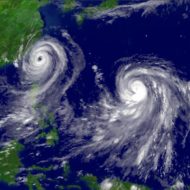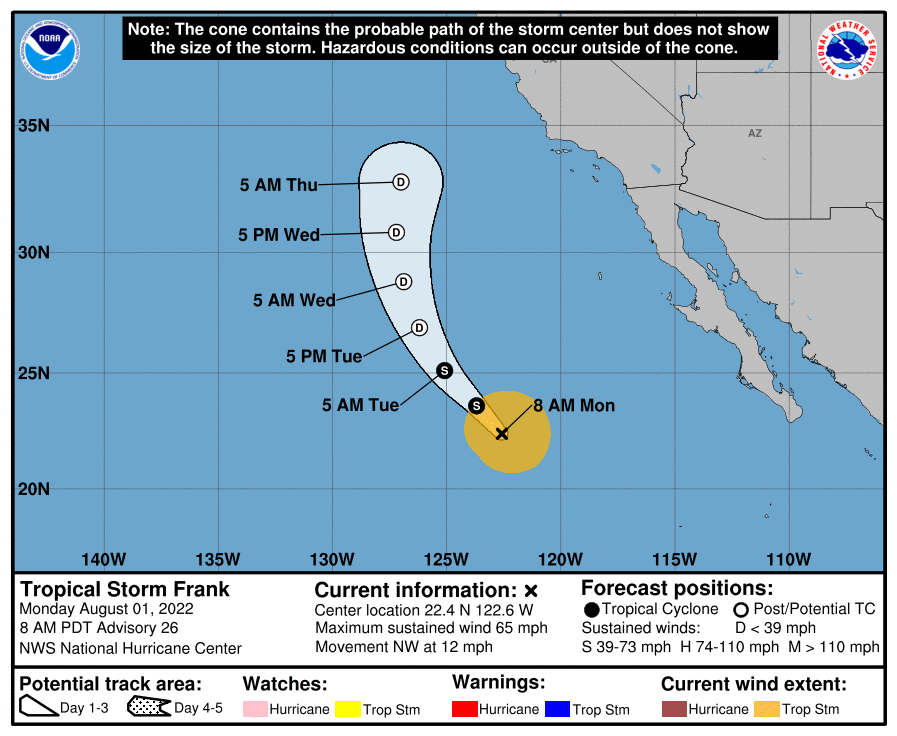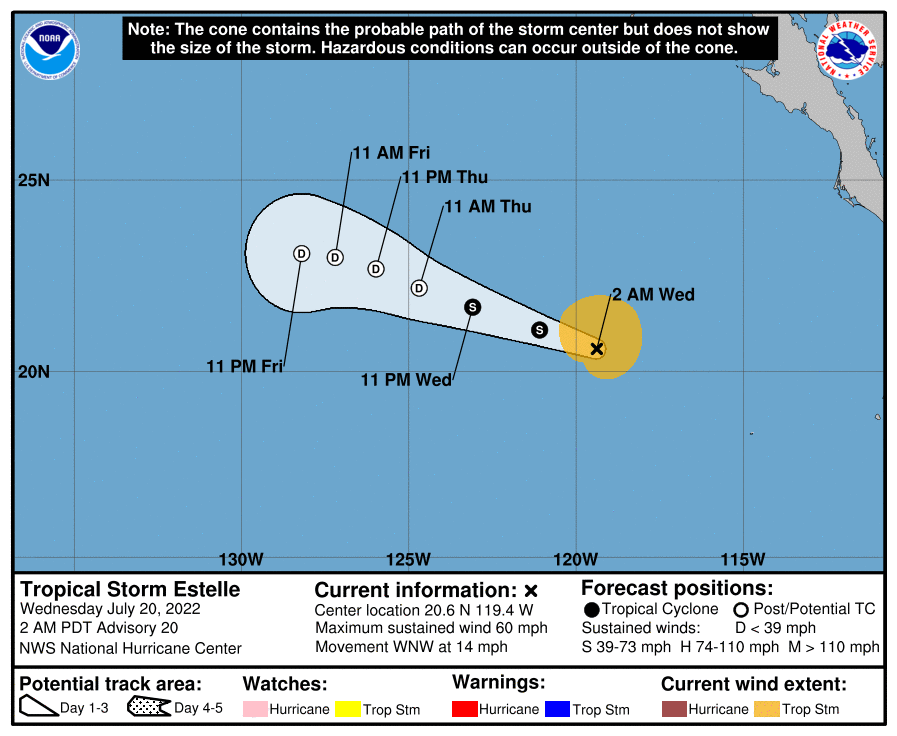KMZ last updated Mon, 15 Aug 2022 14:41:57 GMT
Source link
Advisory #013 Forecast Track [kmz] – Hurricane Howard (EP4/EP092022)
KMZ last updated Tue, 09 Aug 2022 14:39:05 GMT
Source link
Tropical Depression Nine-E Forecast Discussion
480 WTPZ44 KNHC 071441 TCDEP4 Tropical Depression Nine-E Discussion Number 5 NWS National Hurricane Center Miami FL EP092022 900 AM MDT Sun Aug 07 2022 The depression remains disheveled this morning, with the center of the system still partially exposed to the southwest of the deepest convective activity. This structure is primarily due to dry air being imported to the center by moderate southwesterly vertical wind shear (VWS). Subjective Dvorak intensity estimates were T2.5/35 kt from TAFB, T2.0/30 kt from SAB, while the latest objective estimate from UW-CIMSS ADT was T2.5/35 kt. Given the lackluster satellite presentation, the initial intensity was held at 30 kt for this advisory. The depression is now moving northwest as a slightly slower pace, estimated at 315/10 kt. A mid-level ridge located northeast of the system is expected to steer it generally northwestward over the next few days. One interesting note in the immediate future is there is a weakness in this ridge to the north, partially related to an upper-level trough currently shearing the depression. If the system is able to become better aligned vertically, this could lead to a rightward shift in the short-term track. The NHC track forecast accounts for this possibility by being located on the right side of the track guidance envelope over the next 12-36 hours. This track is just a bit northeast of the previous one, though it blends back towards the consensus aids by the end of the forecast, when the system will likely be steered by the low-level trade wind flow. A weak upper-level trough located northwest of the depression is the primary feature maintaining southwesterly VWS over the system. Over the next day or so, both the GFS and ECMWF suggest this feature should decay and shift southwest, perhaps related to convection building up-shear around the depression while helping to align its low and mid-level centers. Should this process occur, intensification still appears possible. One alternate solution is that convective outflow is not able to displace the upper-level low and some amount of shear is maintained over the system. For now, the latest NHC intensity forecast will maintain a peak of 45 kt in 36-48 hours, right around the time the system will be crossing the 26 C sea surface temperature (SST) isotherm. After that time, weakening is expected over even cooler SSTs and a more stable environment. The system is still expected to become a post-tropical remnant low at the end of the forecast period. This intensity forecast is on the high side of the guidance envelope overall, but is close to the latest HCCA consensus aid. FORECAST POSITIONS AND MAX WINDS INIT 07/1500Z 16.8N 109.9W 30 KT 35 MPH 12H 08/0000Z 17.9N 111.1W 35 KT 40 MPH 24H 08/1200Z 19.4N 112.6W 40 KT 45 MPH 36H 09/0000Z 20.7N 114.2W 45 KT 50 MPH 48H 09/1200Z 21.7N 115.9W 45 KT 50 MPH 60H 10/0000Z 22.5N 117.7W 40 KT 45 MPH 72H 10/1200Z 23.1N 119.3W 35 KT 40 MPH 96H 11/1200Z 24.0N 122.5W 30 KT 35 MPH 120H 12/1200Z 24.0N 125.5W 25 KT 30 MPH...POST-TROP/REMNT LOW $$ Forecaster Papin
Advisory #029 Forecast Track [kmz] – Tropical Depression Georgette (EP3/EP082022)
KMZ last updated Wed, 03 Aug 2022 14:41:10 GMT
Source link
TROPICAL STORM FRANK
TROPICAL STORM FRANK
Coastal Watches/Warnings and Forecast Cone for Storm Center

* If the storm is forecast to dissipate within 3 days, the “Full Forecast” and “3 day” graphic will be identical
Click Here for a 5-day Cone Printer Friendly Graphic
How to use the cone graphic (video):

About this product:
This graphic shows an approximate representation of coastal areas under a hurricane warning (red), hurricane watch (pink),
tropical storm warning (blue) and tropical storm watch (yellow). The orange circle indicates the current position of the
center of the tropical cyclone. The black line, when selected, and dots show the National Hurricane Center (NHC) forecast track of the center
at the times indicated. The dot indicating the forecast center location will be black if the cyclone is forecast to be
tropical and will be white with a black outline if the cyclone is forecast to be extratropical. If only an L is displayed,
then the system is forecast to be a remnant low. The letter inside the dot indicates the NHC’s forecast intensity for that time:
D: Tropical Depression – wind speed less than 39 MPH
S: Tropical Storm – wind speed between 39 MPH and 73 MPH
H: Hurricane – wind speed between 74 MPH and 110 MPH
M: Major Hurricane – wind speed greater than 110 MPH
NHC tropical cyclone forecast tracks can be in error. This forecast
uncertainty is conveyed by the track forecast “cone”, the solid white
and stippled white areas in the graphic. The solid white area depicts
the track forecast uncertainty for days 1-3 of the forecast, while the
stippled area depicts the uncertainty on days 4-5. Historical data
indicate that the entire 5-day path of the center of the tropical
cyclone will remain within the cone about 60-70% of the time. To
form the cone, a set of imaginary circles are placed along the
forecast track at the 12, 24, 36, 48, 72, 96, and 120 h positions,
where the size of each circle is set so that it encloses 67% of the
previous five years official forecast errors. The cone is then formed
by smoothly connecting the area swept out by the set of circles.
It is also important to realize that a tropical cyclone is not a point. Their
effects can span many hundreds of miles from the center. The area
experiencing hurricane force (one-minute average wind speeds of at least
74 mph) and tropical storm force (one-minute average wind speeds of
39-73 mph) winds can extend well beyond the white areas shown enclosing
the most likely track area of the center. The distribution of hurricane
and tropical storm force winds in this tropical cyclone can be seen in
the Wind History graphic linked above.
Considering the combined forecast uncertainties in track, intensity, and size, the
chances that any particular location will experience winds of 34 kt (tropical storm force),
50 kt, or 64 kt (hurricane force) from this tropical cyclone are presented in
tabular form for selected locations and forecast positions. This information is also presented in
graphical form for the 34 kt, 50 kt,
and 64 kt thresholds.
Note: A detailed definition of the NHC track forecast cone is also available.
OpenStreetMap
OpenStreetMap is a map of the world, created by people like you and free to use under an open license.
Hosting is supported by UCL, Fastly, Bytemark Hosting, and other partners.
Advisory #009 Forecast Track [kmz] – Tropical Storm Frank (EP2/EP072022)
KMZ last updated Thu, 28 Jul 2022 08:49:42 GMT
Source link
Tropical Depression Seven-E Forecast Discussion
000 WTPZ42 KNHC 260856 CCA TCDEP2 Tropical Depression Seven-E Discussion Number 1...Corrected NWS National Hurricane Center Miami FL EP072022 400 AM CDT Tue Jul 26 2022 Conventional satellite imagery shows that deep convection associated with the low pressure area south of southern Mexico has continued to increase and become better organized. An earlier SSMIS microwave overpass revealed an improved low-level structure, although most of the deep convection was located over the western portion of the system due to moderate easterly shear. A couple of scatterometer overpasses between 0330 and 0500 UTC showed that the circulation had become much better defined and the system had peak winds around 30 kt. Subjective Dvorak T-numbers from SAB and TAFB have also increased to T2.0, and based on all the above data, advisories are being initiated on Tropical Depression Seven-E. The initial wind speed is set at 30 kt, in agreement with both the ASCAT data and the subjective Dvorak estimates. Moderate easterly shear is forecast to plague the system over the next 24 to 48 hours, however most of the intensity guidance suggests gradual strengthening will occur during that time. The official forecast follows suit and calls for the depression to become a tropical storm later today or tonight. After 48 hours, the shear is expected to abate while the system is over SSTs of 28-29C and within a moist low- to mid-level environment. Those conditions favor a faster rate of strengthening, and this is reflected in the NHC forecast which shows the system becoming a hurricane in about 72 hours. The intensity forecast is in good agreement with the HCCA and IVCN consensus aids and is also supported by the global model guidance which depicts more significant deepening in 2-3 days. The initial motion estimate is a somewhat uncertain 280/10 kt. The cyclone is expected to continue westward for the next few days while it is steered by a subtropical ridge that extends westward from northern Mexico. After that time, the GFS and ECMWF models develop a slight weakness in the ridge off the coast of Baja California which allows the system to turn west-northwestward. The UKMET depicts a stronger ridge and a more westward track than the remainder of the guidance and its ensemble mean. As a result, the official forecast is closer to a blend of the GFS and ECMWF models, and a bit north and east of the TVCE multi-model consensus. FORECAST POSITIONS AND MAX WINDS INIT 26/0900Z 11.4N 101.8W 30 KT 35 MPH 12H 26/1800Z 11.8N 103.6W 35 KT 40 MPH 24H 27/0600Z 12.1N 105.6W 40 KT 45 MPH 36H 27/1800Z 12.2N 107.4W 45 KT 50 MPH 48H 28/0600Z 12.5N 109.1W 50 KT 60 MPH 60H 28/1800Z 12.8N 110.8W 60 KT 70 MPH 72H 29/0600Z 13.3N 112.6W 70 KT 80 MPH 96H 30/0600Z 14.9N 116.2W 80 KT 90 MPH 120H 31/0600Z 17.5N 119.7W 80 KT 90 MPH $$ Forecaster Brown
OpenStreetMap
OpenStreetMap is a map of the world, created by people like you and free to use under an open license.
Hosting is supported by UCL, Fastly, Bytemark Hosting, and other partners.
TROPICAL STORM ESTELLE
TROPICAL STORM ESTELLE
Coastal Watches/Warnings and Forecast Cone for Storm Center

* If the storm is forecast to dissipate within 3 days, the “Full Forecast” and “3 day” graphic will be identical
Click Here for a 5-day Cone Printer Friendly Graphic
How to use the cone graphic (video):

About this product:
This graphic shows an approximate representation of coastal areas under a hurricane warning (red), hurricane watch (pink),
tropical storm warning (blue) and tropical storm watch (yellow). The orange circle indicates the current position of the
center of the tropical cyclone. The black line, when selected, and dots show the National Hurricane Center (NHC) forecast track of the center
at the times indicated. The dot indicating the forecast center location will be black if the cyclone is forecast to be
tropical and will be white with a black outline if the cyclone is forecast to be extratropical. If only an L is displayed,
then the system is forecast to be a remnant low. The letter inside the dot indicates the NHC’s forecast intensity for that time:
D: Tropical Depression – wind speed less than 39 MPH
S: Tropical Storm – wind speed between 39 MPH and 73 MPH
H: Hurricane – wind speed between 74 MPH and 110 MPH
M: Major Hurricane – wind speed greater than 110 MPH
NHC tropical cyclone forecast tracks can be in error. This forecast
uncertainty is conveyed by the track forecast “cone”, the solid white
and stippled white areas in the graphic. The solid white area depicts
the track forecast uncertainty for days 1-3 of the forecast, while the
stippled area depicts the uncertainty on days 4-5. Historical data
indicate that the entire 5-day path of the center of the tropical
cyclone will remain within the cone about 60-70% of the time. To
form the cone, a set of imaginary circles are placed along the
forecast track at the 12, 24, 36, 48, 72, 96, and 120 h positions,
where the size of each circle is set so that it encloses 67% of the
previous five years official forecast errors. The cone is then formed
by smoothly connecting the area swept out by the set of circles.
It is also important to realize that a tropical cyclone is not a point. Their
effects can span many hundreds of miles from the center. The area
experiencing hurricane force (one-minute average wind speeds of at least
74 mph) and tropical storm force (one-minute average wind speeds of
39-73 mph) winds can extend well beyond the white areas shown enclosing
the most likely track area of the center. The distribution of hurricane
and tropical storm force winds in this tropical cyclone can be seen in
the Wind History graphic linked above.
Considering the combined forecast uncertainties in track, intensity, and size, the
chances that any particular location will experience winds of 34 kt (tropical storm force),
50 kt, or 64 kt (hurricane force) from this tropical cyclone are presented in
tabular form for selected locations and forecast positions. This information is also presented in
graphical form for the 34 kt, 50 kt,
and 64 kt thresholds.
Note: A detailed definition of the NHC track forecast cone is also available.



